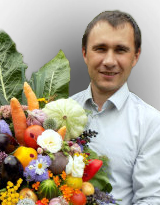THE DEVELOPMENT OF THE LEAF APPARATUS OF GARDEN PEAS IN THE CULTURE OF MICROGREENS, DEPENDING ON THE INTENSITY OF LED LIGHTING
Abstract
The study results of the formation of the leaf apparatus by microgreens of garden peas, depending on the intensity of LED lighting – 50, 100, 150, 200 and 250 mcM/m2·sec. When estimating the length and width of the leaf, calculating the index and the area of the leaf, as well as the area of the total leaf surface on the 10th day of growing microgreens, it was found that the most formed leaves were samples of garden peas grown under LED lighting with an intensity of 100 mcM/m2·sec. While plants grown at an intensity of 200 mcM/m2·sec and experimental intensities of 50 and 150 mcM/m2·sec had lower biometric indicators of the microgreens leaf apparatus.
References
1. Assessment of vitamin and carotenoid concentrations of emerging food products: Edible microgreens / Z. Xiao [et al.] // Journal of Agricultural and Food Chemistry. – 2012. – Vol. 60. – P. 7644–7651.
2. Profiling polyphenols in five Brassica species microgreens by UHPLC-PDAESI/HMRSn / J. Sun [et al.] // Journal of Agricultural and Food Chemistry. – 2013. – Vol. 61. – P. 10960–10970.
3. Microgreens: A new specialty crop: conf. paper / D. Treadwel [et al.] // University of Florida, 2010. – P. 1164.
4. Micro-scale vegetable production and the rise of microgreens / M. C. Kyriacou [et al.] // Trends in Food Science & Technology. – 2016. – Vol. 57. – P. 103–115.
5. Ebert, A. W. Sprouts, microgreens, and edible flowers: the potential for high value specialty produce in Asia: conf. paper from the SEAVEG, 24–26 Jan. 2012 / A. W. Ebert. – Chiang Mai, 2012. – P. 216–227.
6. Small-seeded legumes as a novel food source. Variation of nutritional, mineral and photochemical profiles in the chain: raw seeds-sprouted seeds-microgreens / B. Butkutė [et al.] // Molecules. – 2019. – Vol. 24. – P. 1–18.
7. Achievements and challenges in improving the nutritional quality of food legumes / M. C. Vaz Patto [et al.] // Critical reviews in plant sciences. – 2015. – Vol. 34, №. 1–3. – P. 105–143.
8. Путина, О. В. Углеводный состав семян и его связь с другими селекционно значимыми признаками у овощного гороха (Pisum sativum L.) в условиях Краснодарского края / О. В. Путина, С. В. Бобков, М. А. Вишнякова // Сельскохозяйственная биология. – 2018. – Т. 53. – № 1. – С. 179–188.
9. Evaluation and correlation of sensory attributes and chemical compositions of emerging fresh produce: Microgreens / Z. Xiao [et al.] // Postharvest Biology and Technology. – 2015. – Vol. 110. – P. 140–148.
10. Turner, E. R. Microgreen nutrition, food safety, and shelf life / E. R. Turner, Y. Luo, R. Buchanan // Journal of Food Science. – 2020. – Vol. 85 (4). – Р. 870–882.
11. Different Microgreen Genotypes Have Unique Growth and Yield Responses to Intensity of Supplemental PAR from Light-emitting Diodes during Winter Greenhouse Production in Southern Ontario, Canada / J. Chase [et al.] // Scientia Horticulturae. – 2020. – Vol. 55. – P. 156–163.
12. A review on the effects of light-emitting diode (LED) light on the nutrients of sprouts and microgreens / X. Zhang [et al.] // Trends in Food Science & Technology. – 2020. – Vol. 99. – Р. 1–15.
13. Blue and Red LED Illumination Improves Growth and Bioactive Compounds Contents in Acyanic and Cyanic Ocimum basilicum L. Microgreens / A. Lobiuc [et al.] // Molecules. – 2017. – Vol. 22 (2111). – Р. 1–14.
14. Changes in mineral element content of microgreens cultivated under different lighting conditions in a greenhouse / A. Brazaitytė [et al.] // Acta Horticulturae. – 2018. – Vol. 1227. – P. 507–516.
15. Comparison of LED and HPS illumination effects on cultivation of red pak choi microgreens under indoors and greenhouse conditions / A. Brazaitytė [et al.] // Acta Horticulturae. – 2020. – Vol. 1287. – P. 395–402.
16. Growth and morphology responses to narrow-band blue light and its co-action with low-level UVB or green light: A comparison with red light in four microgreen species / K. Yun [et al.] // Environmental and Experimental Botany. – 2020. – Vol. 178 (104189). – Р. 1–11.
17. Светокультура растений: биофизические и биотехнологические основы/ А. А. Тихомиров [и др.]. – Новосибирск: Изд. Сиб. отд. РАН, 2000. – 213 с.
18. Доспехов, Б. А. Методика полевого опыта (с основами статистической обработки результатов исследований) / Б. А. Доспехов.– 5-е изд., доп. и перераб. – М.: Агропромиздат, 1985. – 351 с.
19. Дмитриев, Н. Н. Методика ускоренного определения площади листовой поверхности сельскохозяйственных культур с помощью компьютерной технологии / Н. Н. Дмитриев, Ш. К. Хуснидинов // Вестн. КрасГАУ. – 2016. – № 7. – С. 88–93.
20. Боровиков, В. П. STATISTICA: искусство анализа данных на компьютере: для профессионалов / В. П. Боровиков. – СПб.: Питер, 2003. – Изд. 2-е. – 686 с.
21. Теория вероятностей и математическая статистика. Математические модели: учеб. пособ. для студ. высш. учеб. заведений / В. Д. Мятлев [и др.]. – М.: Академия. – 2009. – 320 с.
Review
For citations:
Pashkevich A.M. THE DEVELOPMENT OF THE LEAF APPARATUS OF GARDEN PEAS IN THE CULTURE OF MICROGREENS, DEPENDING ON THE INTENSITY OF LED LIGHTING. Vegetable Growing. 2022;30:72-80. (In Russ.)

















